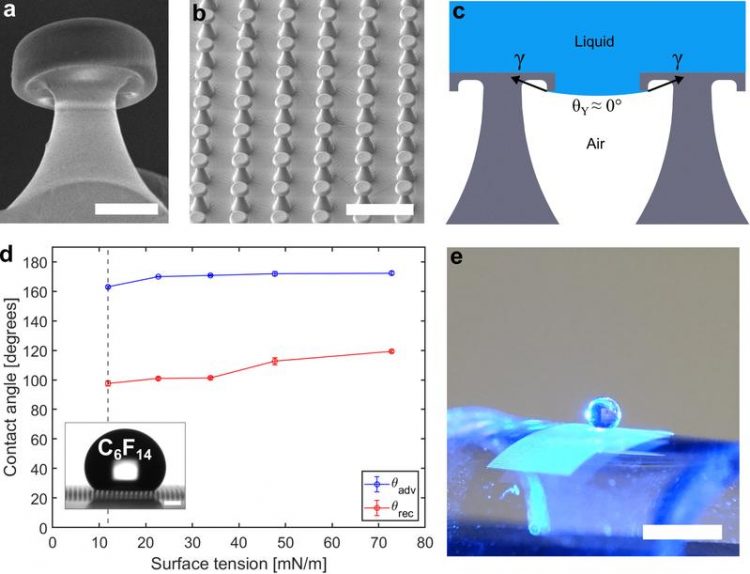Scientists outsmart nature by building super liquid-repellent dry adhesives

Figure 1: Bioinspired liquid super-repellent dry adhesives MPI für Intelligente Systeme
Scientists at the Max Planck Institute for Intelligent Systems (MPI-IS) in Stuttgart have developed a bioinspired reversible dry adhesive material that is able to repel all liquids, regardless of their surface tension.
While dry adhesives have been actively studied and applied for two decades, a super liquid-repellent dry adhesive has never been achieved before.
“Our material effectively repels not only water, but any liquid. Oils, for example, which easily wet surfaces due to their low surface tension, would normally spread on and between the fibrils – the fine hairs – causing them to clump together and lose adhesion. But because of the specific tip structure we have created, our fibrils can fend off all liquids, including oils,” Ville Liimatainen explains, highlighting the key feature of the adhesive.
Liimatainen is a postdoctoral researcher in the Physical Intelligence Department at the MPI-IS and lead author of the publication “Liquid‐Superrepellent Bioinspired Fibrillar Adhesives”, which was recently published in Advanced Materials.
The senior author is Metin Sitti, a Director at MPI-IS and head of the Physical Intelligence Department. Sitti is a pioneer in the research field of gecko-inspired dry adhesives. He is also the founder of nanoGriptech Inc., a start-up that commercialized several nature-inspired dry adhesives.
Most of the Physical Intelligence department’s research is inspired by nature and the blueprints it provides, and this project was no exception. Ville Liimatainen, Dirk Drotlef, Donghoon Son, and Metin Sitti took inspiration from the tiny fibrils on a gecko’s footpads.
Each one is covered with hundreds of thousands of tiny mushroom-shaped knobs, which allow the animal to effortlessly climb up practically any surface. Synthetic mimics of these fibrillar adhesive systems have been studied for decades, with performance reaching and sometimes even surpassing that of geckos.
Dry adhesives do not require any chemicals or glue to make them stick to almost any surface. Moreover, they are reusable, soft, bendable, and stretchable. However, they fail when they get wet, as do gecko footpads: faced with wet conditions, the gecko’s ability to adhere to slippery surfaces decreases dramatically.
Scientists outsmart nature
By changing the shape of the fibril tips, the scientists were able to outsmart nature and make their dry adhesive super-repellent to water and other liquids.
“To give you examples: Gecko-inspired dry adhesives would now be able to stick to any wet surface without any adhesion loss, and a climbing robot using bioinspired dry adhesives would be able to climb on surfaces with any liquids. Alternately, a robot hand equipped with a layer of such an adhesive would be able to pick-and-place any object covered in liquid,” Sitti adds.
As seen in figure 1c, the arrows represent the vectors of the surface tension. Even if a liquid can spread to the bottom corners of the fibril tips, surface tension will have an upward- pointing component, as indicated by the arrows.
This force supports the liquid, which then cannot slip down between the fibrils. “This is all thanks to the overhanging T-shape geometry of the fibril tip, which can stop even ultralow-surface-tension liquids,” Liimatainen explains.
Each fibril is 40 micrometers in height and 10 micrometers thick at the narrowest point just underneath the cap, which has a diameter of 28 micrometers. This size ratio combined with the special fibril tip shape and the use of stretchable, scratch-resistant soft silicone elastomer as the building material enables durable dry adhesives with strong adhesion and extreme liquid repellency.
https://onlinelibrary.wiley.com/doi/full/10.1002/adma.202000497
Media Contact
All latest news from the category: Materials Sciences
Materials management deals with the research, development, manufacturing and processing of raw and industrial materials. Key aspects here are biological and medical issues, which play an increasingly important role in this field.
innovations-report offers in-depth articles related to the development and application of materials and the structure and properties of new materials.
Newest articles

First-of-its-kind study uses remote sensing to monitor plastic debris in rivers and lakes
Remote sensing creates a cost-effective solution to monitoring plastic pollution. A first-of-its-kind study from researchers at the University of Minnesota Twin Cities shows how remote sensing can help monitor and…

Laser-based artificial neuron mimics nerve cell functions at lightning speed
With a processing speed a billion times faster than nature, chip-based laser neuron could help advance AI tasks such as pattern recognition and sequence prediction. Researchers have developed a laser-based…

Optimising the processing of plastic waste
Just one look in the yellow bin reveals a colourful jumble of different types of plastic. However, the purer and more uniform plastic waste is, the easier it is to…



